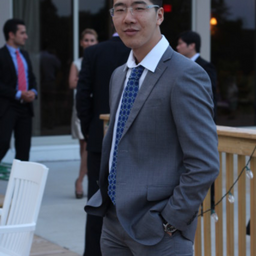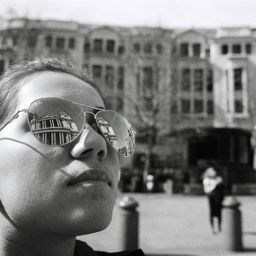what is the best answer to the following expression? (12.125+0.530+71.4)
Trouble 1
Monochromatic lite from a distant source is incident on a slit 0.750 mm wide. On a screen 2.00 $\mathrm{thou}$ abroad, the distance from the central maximum of the diffraction pattern to the outset minimum is measured to be one.35 $\mathrm{mm}$ . Summate the wavelength of the lite.

Sri Datta Vikas B.
Numerade Educator
Problem 2
Parallel rays of light-green mercury light with a wavelength of 546 $\mathrm{nm}$ pass through a slit covering a lens with a focal length of $60.0 \mathrm{cm} .$ In the focal airplane of the lens the altitude from the central maximum to the first minimum is x.two $\mathrm{mm}$ . What is the width of the slit?

Donald A.
Numerade Educator
Trouble 3
Light of wavelength 585 $\mathrm{nm}$ falls on a slit 0.0666 $\mathrm{mm}$ wide. (a) On a very large distant screen, how many totally dark fringes (indicating complete cancellation) volition there be, including both sides of the central bright spot? Solve this problem without calclating all the anglest (Hint: What is the largest that sin $\theta$ tin can be? What does this tell y'all is the largest that $m$ tin can exist vii (b) At what
bending will the dark fringe that is most distant from the central bright fringe occur?

Mayukh B.
Numerade Educator
Problem 4
Light of wavelength 633 $\mathrm{nm}$ from a distant source is incident on a slit 0.750 $\mathrm{mm}$ wide, and the resulting diffraction pattern is observed on a screen three.50 $\mathrm{m}$ away. What is the distance betwixt the 2 dark fringes on either side of the key bright fringe?

Haoran S.
Kent State Academy
Problem v
Diffraction occurs for all types of waves, including sound waves. High-frequency sound from a distant source with wave-length ix.00 $\mathrm{cm}$ passes through a narrow slit 12.0 $\mathrm{cm}$ wide. A
microphone is placed 40.0 $\mathrm{cm}$ directly in front end of the heart of the slit, corresponding to betoken $O$ in Fig. 36.five $\mathrm{a}$ . The microphone is then moved in a direction perpendicular to the line from the center of the slit to point $O$ . At what distances from $O$ volition the intensity detected by the microphone be zero?

Mayukh B.
Numerade Educator
Problem 6
Tsunamit On Dec $26,2004,$ a violent magnitude 9.1 earthquake occurred off the coast of Sumatra. This quake triggered a huge tsunami (similar to a tidal moving ridge) that killed more than than $150,000$ people. Scientists observing the wave on the open up ocean measured the time betwixt crests to be 1.0 $\mathrm{h}$ and the speed of the wave to exist 800 $\mathrm{km} / \mathrm{h}$ . Computer models of the evolution of this enormous wave showed that it bent effectually the continents and spread to all the oceans of the earth. When the wave reached the gaps between continents, it diffracted between them equally through a slit. (a) What was the wavelength of this tsunami? (b) The altitude betwixt the southern tip of Africa and northern Antarctica is about 4500 $\mathrm{km}$ , while the distance between the southern terminate of Australia and Antarctica is well-nigh 3700 $\mathrm{km}$ . As an approximation, we can model this wave'due south behavior by using Fraunhofer diffraction. Find the smallest angle away from the central maximum for which the waves would cancel after going through each of these continental gaps.

Mayukh B.
Numerade Educator
Trouble 7
A series of parallel linear water moving ridge fronts are traveling directly toward the shore at 15.0 $\mathrm{cm} / \mathrm{due south}$ on an otherwise placid lake. A long concrete barrier that runs parallel to the shore at a distance of 3.20 $\mathrm{k}$ abroad has a pigsty in information technology. Y'all count the wave crests and find that 75.0 of them laissez passer by each minute, and you lot also observe that no waves accomplish the shore at $\pm 61.3 \mathrm{cm}$ from the signal directly reverse the hole, only waves practise reach the shore everywhere inside this distance. (a) How broad is the pigsty in the barrier? (b) At what other angles do you lot observe no waves hitting the shore?
Lalit Y.
Numerade Educator
Problem 8
Monochromatic light of wavelength 580 $\mathrm{nm}$ passes through a single slit and the diffraction blueprint is observed on a screen. Both the source and screen are far enough from the slit for Fraunhofer diffraction to apply. (a) If the showtime diffraction minima are at $\pm 90.0^{\circ},$ so the cardinal maximum completely fills the screen, what is the width of the slit? (b) For the width of the slit as calculated in role (a), what is the ratio of the intensity at $\theta=45.0^{\circ}$ to the intensity at $\theta=0 ?$

Sri Datta Vikas B.
Numerade Educator
Problem 9
Doorway Diffraction. Sound of frequency 1250 $\mathrm{Hz}$ leaves a room through a 1.00 -m-wide doorway (see Exercise 36.five$)$ . At which angles relative to the centerline perpendicular to the door- mode will someone ourside the room hear no sound? Use 344 $\mathrm{m} / \mathrm{southward}$ for the speed of audio in air and presume that the source and listener are both far plenty from the doorway for Fraunhofer diffraction to apply. Yous can ignore effects of reflections.

Mayukh B.
Numerade Educator
Problem ten
Light waves, for which the electric field is given past $E_{y}(ten, t)=E_{\max } \sin \left[\left(1.xx \times x^{7} \mathrm{m}^{-1}\right) ten-\omega t\right],$ pass through a slit and produce the first dark bands at $\pm 28.6^{\circ}$ from the middle of the diffraction patterm. (a) What is the frequency of this light? (b) How broad is the slit? (c) At which angles will other night bands occur?

Mayukh B.
Numerade Educator
Trouble 11
Parallel rays of light with wavelength 620 $\mathrm{nm}$ pass through a slit roofing a lens with a focal length of 40.0 $\mathrm{cm}$ . The diffraction pattern is observed in the focal aeroplane of the lens, and the distance from the center of the central maximum to the first minimum is $36.5 \mathrm{cm} .$ What is the width of the slit? (Note: The angle that locates the get-go minimum is non small.)

Donald A.
Numerade Educator
Problem 12
Monochromatic electromagnetic radiations with wavelength $\lambda$ from a distant source passes through a slit. The diffraction design is observed on a screen 2.50 $\mathrm{yard}$ from the slit. If the width of the cardinal maximum is $vi.00 \mathrm{mm},$ what is the slit width $a$ if the wavelength is (a) 500 $\mathrm{nm}$ (visible lite); (b) l.0$\mu \mathrm{thousand}$ (infrared radiation); (c) 0.500 $\mathrm{nm}$ (x rays)?

Haoran S.
Kent State University
Problem 13
Blood-red light of wavelength 633 $\mathrm{nm}$ from a helium-neon laser passes through a slit 0.350 $\mathrm{mm}$ wide. The diffraction blueprint is observed on a screen 3.00 $\mathrm{m}$ away. Define the width of a vivid fringe as the altitude betwixt the minima on either side. (a) What is the width of the fundamental bright fringe? (b) What is the width of the kickoff bright fringe on either side of the fundamental one?

Sri Datta Vikas B.
Numerade Educator
Problem 14
Monochromatic light of wavelength $\lambda=620 \mathrm{nm}$ from a distant source passes through a slit 0.450 $\mathrm{mm}$ broad. The diffraction pattern is observed on a screen 3.00 $\mathrm{m}$ from the slit. In terms of the intensity $I_{0}$ at the pinnacle of the central maximum, what is the intensity of the light at the screen the following distances from the center of the central maximum: (a) $i.00 \mathrm{mm} ;$ (b) 3.00 $\mathrm{mm}$ ; (c) 5.00 $\mathrm{mm}$ ?

Haoran S.
Kent State Academy
Problem fifteen
A slit 0.240 $\mathrm{mm}$ wide is illuminated by parallel light rays of wavelength 540 $\mathrm{nm}$ . The diffraction design is observed on a screen that is 3.00 $\mathrm{m}$ from the slit. The intensity at the center of the primal maximum $\left(\theta=0^{\circ}\right)$ is $vi.00 \times x^{-6} \mathrm{Westward} / \mathrm{m}^{2} .$ (a) What is the distance on the screen from the center of the key maximum to the first minimum? (b) What is the intensity at a point on the screen midway between the centre of the central maximum and the offset minimum?

Khoobchandra A.
Numerade Educator
Trouble 16
Laser light of wavelength 632.8 $\mathrm{nm}$ falls normally on a slit that is 0.0250 $\mathrm{mm}$ wide. The transmitted light is viewed on a distant screen where the intensity at the middle of the primal bright fringe is $viii.50 \mathrm{West} / \mathrm{1000}^{2} .$ (a) Find the maximum number of totally dark fringes on the screen, assuming the screen is large enough to evidence them all. (b) At what angle does the dark fringe that is most afar from the middle occur? (c) What is the maximum intensity of the brilliant fringe that occurs immediately before the night fringe in role (b)? Approximate the angle at which this fringe occurs past assuming it is midway between the angles to the dark fringes on either side of it.

Sri Datta Vikas B.
Numerade Educator
Problem 17
A single-slit diffraction design is formed by monochromatic electromagnetic radiation from a distant source passing through a slit 0.105 $\mathrm{mm}$ wide. At the point in the pattern $three.25^{\circ}$ from the center of the central maximum, the total phase deviation between wavelets from the tup and bottom of the slit is 56.0 rad. (a) What is the wavelength of the radiation? (b) What is the intensity at this point, if the intensity at the center of the primal maximum is $I_{0} ?$

Mayukh B.
Numerade Educator
Trouble eighteen
Consider a single-slit diffraction experiment in which the aamplitude of the wave at point $O$ in Fig. 36.5 a is $E_{0} .$ For each of the following cases, draw a phasor diagram like that in Fig. 36.8 $\mathrm{c}$
and decide graphically the amphtude of the moving ridge at the point in question. (Hint: Use Eq. (36.6) to determine the value of $\beta$ for each case.) Compute the intensity and compare to Eq. $(36.5)$ . (a) $\sin \theta=\lambda / 2 a ;(b) \sin \theta=\lambda / a ;(c) \sin \theta=3 \lambda / 2 a$

Mayukh B.
Numerade Educator
Problem 19
Public Radio station KXPR-FM in Sacramento broadcasts at 88.9 $\mathrm{MHz}$ . The radio waves pass betwixt two tall skyscrapers that are 15.0 $\mathrm{thousand}$ apart along their closest walls. (a) At what horizontal angles, relative to the original direction of the waves, will a distant antenna not receive any signal from this station? (b) If the maximum intensity is three.50 $\mathrm{W} / \mathrm{m}^{2}$ at the antenna, what is the intensity at $\pm 5.00^{\circ}$ from the center of the central maximum at the afar antenna?

Dading C.
Numerade Educator
Problem 20
Diffraction and Interference Combined. Consider the interference pattern produced by two parallel slits of width $a$ and separation $d,$ in which $d=3 a$ . The slits are illuminated past normally incident light of wavelength $\lambda$ . (a) Kickoff we ignore diffraction effects due to the slit width. At what angles $\theta$ from the central maximum volition the next four maxima in the 2-slit interference pattern occur? Your reply volition be in terms of $d$ and $\lambda .$ (b) Now we include the effects of diffraction. If the intensity at $\theta=0$ is $I_{0}$ , what is the intensity at each of the angles in part (a)? (c) Which double-slit interference maxima are missing in the pattern? (d) Compare your results to those illustrated in Fig. 36.12 $\mathrm{c}$ . In what means is your result different?

Donald A.
Numerade Educator
Problem 21
Number of Fringes in a Diffraction Maximum. In Fig. 36.12 $\mathrm{c}$ the central diffraction maximum contains exactly vii interference fringes, and in this case $d / a=iv .(\mathrm{a})$ What must the ratio $d / a$ be if the primal maximum contains exactly five fringes? (b) In the case considered in part (a), how many fringes are contained within the first diffraction maximum on 1 side of the central maximum?

Mayukh B.
Numerade Educator
Problem 22
An interference pattern is produced by eight parallel and equally spaced, narrow slits. In that location is an interference minimum when the phase difference $\phi$ between lite from adjacent slits is $\pi / 4$ . The phasor diagram is given in Fig. $36.fourteen b .$ For which pairs of slits is in that location totally destructive interference?

Khoobchandra A.
Numerade Educator
Problem 23
An interference pattern is produced by light of wavelength 580 $\mathrm{nm}$ from a distant source incident on two identical parallel slits separated by a distance (between centers) of 0.530 $\mathrm{mm}$ . (a) If the slits are very narrow, what would be the angular positions of the first-order and second-order, two-slit, interference maxima? (b) Let the slits accept width 0.320 $\mathrm{mm}$ , In terms of the intensity $I_{0}$ at the center of the fundamental maximum, what is the intensity at each of the athwart positions in part (a)?

Sri Datta Vikas B.
Numerade Educator
Problem 24
Monochromatic lite illuminates a pair of sparse parallel slits at normal incidence, producing an interference design on a distant screen. The width of each slit is $\frac{one}{7}$ the center-to-center altitude between the slits. (a) Which interference maxima are missing in the pattem on the screen? (b) Does the reply to office (a) depend on the wavelength of the light used? Does the location of the missing maxima depend on the wavelength?

Mayukh B.
Numerade Educator
Problem 25
An interference pattern is produced by four parallel and every bit spaced, narrow slits. By cartoon appropriate phasor diagrams, show that there is an interference minimum when the phase difference $\phi$ from side by side slits is (a) $\pi / 2 ;(b) \pi ;$ (c) 3$\pi / 2$ . In each case, for which pairs of slits is at that place totally destructive interference?

Donald A.
Numerade Educator
Problem 27
Laser calorie-free of wavelength 500.0 $\mathrm{nm}$ illuminates two identical slits, producing an interference blueprint on a screen 90.0 $\mathrm{cm}$ from the slits. The vivid bands are ane.00 $\mathrm{cm}$ apart, and the tertiary bright bands on either side of the central maximum are missing in the blueprint. Observe the width and the separation of the two slits.

Haoran S.
Kent State University
Problem 28
Monochromatic light is at normal incidence on a plane transmission grating. The showtime-order maximum in the interference pattern is at an bending of $eight.94^{\circ} .$ What is the angular position of the fourth-guild maximum?

Sophie Due south.
Numerade Educator
Trouble 29
If a diffraction grating produces its third-lodge bright ring at an angle of $78.4^{\circ}$ for light of wavelength 681 $\mathrm{nm}$ , find (a) the number of slits per centimeter for the grating and $(b)$ the angular location of the first-order and second-order bright bands. (c) Will there be a fourth-society bright ring? Explain.

Sri Datta Vikas B.
Numerade Educator
Problem xxx
If a diffraction grating produces a third-order bright spot for red calorie-free (of wavelength 700 $\mathrm{nm} )$ at $65.0^{\circ}$ from the central maximum, at what angle will the 2nd-order bright spot be for violet
low-cal (of wavelength 400 $\mathrm{nm} ) ?$

Haoran S.
Kent State University
Problem 31
Visible light passes through a diffraction grating that has 900 slits $/ \mathrm{cm},$ and the interference pattern is observed on a screen that is two.fifty $\mathrm{m}$ from the grating. (a) Is the angular position of the offset-order spectrum pocket-sized plenty for $\sin \theta \approx \theta$ to be a good approximation? (b) In the beginning-order spectrum, the maxima for 2 different wavelengths are separated on the screen by 3.00 $\mathrm{mm}$ . What is the difference in these wavelengths?

Sri Datta Vikas B.
Numerade Educator
Trouble 32
The wavelength range of the visible spectrum is approximately $400-700 \mathrm{nm} .$ White calorie-free falls at normal incidence on a diffraction grating that has 350 slits $/ \mathrm{mm}$ . Find the angular width of the visible spectrum in (a) the first lodge and $(\mathrm{b})$ the third guild. (Note: An advantage of working in higher orders is the greater angular spread and meliorate resolution. A disadvantage is the overlapping of different orders, every bit shown in Example 36.iv .

Mayukh B.
Numerade Educator
Problem 33
Measuring Wavelengths with a CD. A light amplification by stimulated emission of radiation beasm of wavelength $\lambda=632.8 \mathrm{nm}$ shines at normal incidence on the reflective side of a meaty disc. The tracks of tiny pits in which information is coded onto the CD are one.sixty$\mu \mathrm{yard}$ apart. For what angles of reflection (measured from the normal) volition the intensity of light be maximum?

Mayukh B.
Numerade Educator
Problem 34
(a) What is the wavelength of light that is deviated in the first order through an bending of $thirteen.5^{\circ}$ past a transmission grating having 5000 slits $/ \mathrm{cm} ?$ (b) What is the second order divergence of this
wavelength? Assume normal incidence.

Narendra K.
Numerade Educator
Trouble 35
Plane monochromatic waves with wavelength 520 $\mathrm{nm}$ are incident normally on a plane transmission grating having 350 slits $\operatorname{mon}$ . Find the angles of deviation in the showtime, second, and third orders.

Mayukh B.
Numerade Educator
Problem 36
Identifying Isotopes by Spectra. Dissimilar isotopes of the same element emit light at slightly unlike wavelengths. A wavelength in the emission spectrum of a hydrogen cantlet is 656.45 $\mathrm{nm}$ ; for deuterium, the corresponding wavelength is $656.27 \mathrm{nm} .$ (a) What minimum number of slits is required to resolve these two wavelengths in second order? (b) If the grating has 500.00 sits $/ \mathrm{mm}$ , find the angles and angular separation of these two wavelengths in the second order.

Mayukh B.
Numerade Educator
Problem 37
A typical laboratory diffraction grating has $5.00 \times$ $x^{3}$ lines $/ \mathrm{cm},$ and these lines are contained in a $3.50-\mathrm{cm}$ width of grating. (a) What is the chromatic resolving power of such a grating in the first society? (b) Could this grating resolve the lines of the sodium doublet (see Section 36.5$)$ in the start lodge? (c) While doing spectral assay of a star, yous are using this grating in the second club to resolve spectral lines that are very close to the 587.8002 -nm spectral line of atomic number 26. (i) For wavelengths longer than the iron line, what is the shortest wavelength you could distinguish from the iron line? (2) For wavelengths shorter than the atomic number 26 line, what is the longest wavelength you could distinguish from the atomic number 26 line? (three) What is the range of wavelengths yous could not distinguish from the atomic number 26 line?

Sri Datta Vikas B.
Numerade Educator
Trouble 38
The light from an iron are includes many different wavelengths. Two of these are at $\lambda=587.9782 \mathrm{nm}$ and $\lambda=$ 587.8002 $\mathrm{nm}$ . You wish to resolve these spectral lines in first order using a grating ane.20 $\mathrm{cm}$ in length. What minimum number of slits per centimeter must the grating have?

Sri Datta Vikas B.
Numerade Educator
Trouble 39
10 rays of wavelength 0.0850 $\mathrm{nm}$ are scattered from the atoms of a crystal. The second-order maximum in the Bragg reflection occurs when the angle $\theta$ in Fig. 36.23 is $21.5^{\circ} .$ What is the spacing between next diminutive planes in the crystal?

Sri Datta Vikas B.
Numerade Educator
Problem twoscore
If the planes of a crystal are 3.fifty $\mathrm{A}\left(\mathrm{i} \mathrm{A}=10^{-ten} \mathrm{m}=\right.$ one Angstrom unit) apart, (a) what wavelength of electromagnetic waves is necded so that the starting time strong interference maximum in the Bragg reflection occurs when the waves strike the planes at an angle of $15.0^{\circ}$ , and in what part of the electromagnetic spectrum do these waves prevarication? (See Fig. 32.4.) (b) At what other angles will strong interference maxima occur?

Mayukh B.
Numerade Educator
Problem 41
Due to blurring acquired by atmospheric distortion, the best resolution that tin be obtained past a normal, world-based, visible-light telescope is well-nigh 0.3 arcsecond (there are 60 arcminutes in a caste and 60 arcseconds in an arcminute). (a) Using Rayleigh'south criterion, calculate the diameter of an globe-based telescope that gives this resolution with 550 -nm light. (b) Increasing the telescope diameter beyond the value plant in part (a) will increment the light-gathering power of the telescope, allowing more than distant and dimmer astronomical objects to be studied, but information technology will not ameliorate the resolution. In what means are the Keck telescopes (each of 10- diameter) atop Mauna Kea in Hawaii superior to the Unhurt Telescope ( 5 -m bore) on Palomar Mountain in California? In what ways are they not superior? Explain.

Mayukh B.
Numerade Educator
Problem 42
If you can read the bottom row of your doctor's eye nautical chart, your eye has a resolving power of one arcminute, equal to $\frac{1}{threescore}$ degree. If this resolving ability is diffraction express, to what effective diameter of your centre's optical arrangement does this correspond? Use Rayleigh'southward criterion and assume $\boldsymbol{\lambda}=550 \mathrm{nm} .$

Donald A.
Numerade Educator
Problem 43
Two satellites at an altitude of 1200 $\mathrm{km}$ are separated by 28 $\mathrm{km}$ . If they broadcast $three.vi-\mathrm{cm}$ microwaves, what minimum receiving-dish diameter is needed to resolve (by Rayleigh's criterion) the two transmissions?

Kelley C.
Numerade Educator
Problem 44
The Very Long Baseline Assortment tin resolve (past Rayleigh's criterion) signals from sources separated by $1.0 \times x^{-eight} \mathrm{rad} .$ If the effective diameter of the receiver is 8000 $\mathrm{km}$ , what is the wavelength of these signals?

Mayukh B.
Numerade Educator
Problem 45
Monochromatic low-cal with wavelength 620 $\mathrm{nm}$ passes through a round discontinuity with diameter 7.4$\mu \mathrm{chiliad}$ . The resulting diffraction blueprint is observed on a screen that is iv.v $\mathrm{m}$ from the aperture. What is the diameter of the Airy disk on the screen?

Vishal Grand.
Numerade Educator
Problem 46
Photography. A wildlife photographer uses a moderate telephoto lens of focal length 135 $\mathrm{mm}$ and maximum aperture $f | four.00$ to photograph a bear that is 11.5 $\mathrm{chiliad}$ away. Assume the wavelength is 550 $\mathrm{nm}$ . (a) What is the width of the smallest feature on the deport that this lens can resolve if it is opened to its maximum aperture? (b) If, to gain depth of field, the photographer stops the lens down to $f / 22.0$ , what would be the width of the smallest resolvable feature on the conduct?

Donald A.
Numerade Educator
Problem 47
Observing Jupiter. You lot are asked to pattern a space telescope for globe orbit. When Jupiter is $5.93 \times 10^{8} \mathrm{km}$ away (its closest approach to the world), the telescope is to resolve, by Rayleigh'due south criterion, features on Jupiter that are 250 $\mathrm{km}$ apart. What minimum-diameter mirror is required? Presume a wavelength of 500 $\mathrm{nm}$ .

Mayukh B.
Numerade Educator
Trouble 48
A converging lens vii.20 $\mathrm{cm}$ in diameter has a focal length of 300 $\mathrm{mm}$ . If the resolution is diffraction express, how far away can an object be if points on information technology four.00 $\mathrm{mm}$ autonomously are to be resolved (co-ordinate to Rayleigh'south benchmark)? Use $\lambda=550 \mathrm{nm} .$

Mayukh B.
Numerade Educator
Problem 49
Hubble Versus Arecibo. The Hubble Infinite Telescope has an aperture of ii.iv $\mathrm{m}$ and focuses visible calorie-free $(400-700 \mathrm{nm}) .$ The Arecibo radio telescope in Puerto Rico is 305 $\mathrm{grand}(m \mathrm{ft})$ in diameter (it is built in a mountain valley) and focuses radio waves of wavelength $75 \mathrm{cm} .$ (a) Under optimal viewing conditions, what is the smallest crater that each of these telescopes could resolve on our moon? (b) If the Hubble Space Telescope were to exist converted to surveillance utilize, what is the highest orbit above the surface of the earth it could have and still be able to resolve the license plate (not the messages, just the plate) of a machine on the basis? Assume optimal viewing weather condition, so that the resolution is diffraction limited.

Mayukh B.
Numerade Educator
Problem 50
Searching for Starspots. The Unhurt Telescope on Palomar Mountain in California has a mirror 200 in. $(5.08 \mathrm{chiliad})$ in diameter and information technology focuses visible lite. Given that a large sunspot is about
$10,000 \mathrm{mi}$ in diameter, what is the nigh distant star on which this telescope could resolve a sunspot to see whether other stars take them? (Assume optimal viewing atmospheric condition, so that the resolution is diffraction limited.) Are there whatsoever stars this close to us, besides our sun?

Donald A.
Numerade Educator
Trouble 51
Searching for Planets. The Keck Telescopes, on Mauna Kea, Hawaii have a 10.0 -thou-diameter mirror. Could these telescopes resolve Jupiter-sized planets almost our nearest star, Alpha Centauri, which is four.28 light-years away?

Mayukh B.
Numerade Educator
Problem 52
Suppose the unabridged appliance (slit, screen, and space in between) in Exercise 36.iv is immersed in water $(n=1.33) .$ So what is the altitude betwixt the two dark fringes?

Mayukh B.
Numerade Educator
Problem 53
Consider a single-slit diffraction design. The center of the central maximum, where the intensity is $I_{0}$ , is located at $\boldsymbol{\theta}=0 .$ (a) Permit $\boldsymbol{\theta}_{+}$ and $\boldsymbol{\theta}_{-}$ be the two angles on either side of $\boldsymbol{\theta}=\mathbf{0}$ for which $I=\frac{one}{2} I_{0} . \Delta \theta=\left|\theta_{+}-\theta_{-}\right|$ is called the full width at one-half maximum, or $F W H M,$ of the central diffraction maximum. Solve for $\Delta \theta$ when the ratio betwixt slit width $a$ and wavelength $\lambda$ is (i) $a / \lambda=two ;$ (2) $a / \lambda=5 ;$ (3) $a / \lambda=10$ . (Hint Your equation for $\theta_{+}$ or $\theta_{-}$ cannot be solved analytically. You lot must use trial and mistake or solve information technology graphically. (b) The width of the central maximum tin altematively exist divers as 2$\theta_{0}$ , where $\theta_{0}$ is the angle that locates the minimum on i side of the fundamental maximum. Calculate ii$\theta_{0}$ for each case considered in part (a), and compare to $\Delta \theta .$

Mayukh B.
Numerade Educator
Problem 54
A loudspeaker having a diaphragm that vibrates at 1250 $\mathrm{Hz}$ is traveling at 80.0 $\mathrm{grand} / \mathrm{s}$ directly toward a pair of holes in a very big wall in a region for which the speed of audio is 344 $\mathrm{m} / \mathrm{southward}$ . You lot discover that the sound coming through the openings beginning cancels at $\pm 127^{\circ}$ with respect to the original direction of the speaker when observed far from the wall. (a) How far apart are the two openings? (b) At what angles would the audio starting time abolish if the source stopped moving?

Mayukh B.
Numerade Educator
Trouble 55
Measuring Refractive Index. A thin slit illuminated by light of frequency $f$ produces its first dark band at $\pm 38.2^{\circ}$ in air. When the entire apparatus (slit, screen, and infinite in betwixt) is immersed in an unknown transparent liquid, the slit'south start nighttime bands occur instead at $\pm 17.four^{\circ} .$ Notice the refractive alphabetize of the liquid.

Sri Datta Vikas B.
Numerade Educator
Problem 56
Grating Design. Your boss asks y'all to blueprint a diffraction grating that will disperse the first-society visible spectrum through an angular range of $15.0^{\circ}$ (run across Example 36.iv in Section 36.five ). (a) What must the number of slits per centimeter be for this grating? (b) At what angles volition the showtime order visible spectrum brainstorm and end?

Donald A.
Numerade Educator
Problem 57
A slit 0.360 $\mathrm{mm}$ broad is illuminated by parallel rays of light that accept a wavelength of 540 $\mathrm{nm}$ . The diffraction design is observed on a screen that is one.twenty $\mathrm{k}$ from the slit. The intensity at the centre of the central maximum $\left(\theta=0^{\circ}\right)$ is $I_{0}$ . (a) What is the distance on the screen from the center of the primal maximum to the first minimum? (b) What is the distance on the screen from the center of the central maximum to the bespeak where the intensity has fallen to $I_{0} / 2 ?(\text { See Trouble } 36.53 \text { , part (a), for a hint about how to }$ solve for the phase angle $\beta . )$

Mayukh B.
Numerade Educator
Problem 58
The intensity of light in the Fraunhofer diffraction pattern of a unmarried slit is
$$
I=I_{0}\left(\frac{\sin \gamma}{\gamma}\right)^{2}
$$
where
$$
\gamma=\frac{\pi a \sin \theta}{\lambda}
$$
(a) Show that the equation for the values of $\gamma$ at which $I$ is a maximum is $\tan \gamma=\gamma$ (b) Determine the three smallest positive values of $\gamma$ that are solutions of this equation (Hint: You can use a trial-and-error process. Gauge a value of $\gamma$ and accommodate your guess to bring tan $\gamma$ closer to $\gamma$ A graphical solution of the equation is very helpful in locating the solutions approximately, to get good initial guesses.)

Donald A.
Numerade Educator
Problem 59
Angular Width of a Master Maximum. Consider $North$ evenly spaced, narrow slits. Utilise the small-scale-bending approximation $\sin \theta=\theta(\text { for } \theta \text { in radians) to prove the following: For an intensity }$ maximum that occurs at an bending $\theta$ , the intensity minima immediately adjacent to this maximum are at angles $\theta+\lambda / N d$ and $\theta-\lambda / North d$ , and then that the angular width of the main maximum is ii$\lambda / N d$ . This is proportional to $1 / N,$ as nosotros concluded in Section 36.4 on the footing of free energy conservation.

Mayukh B.
Numerade Educator
Problem threescore
The Expanding Universe. A cosmologist who is studying the light from a galaxy has identified the spectrum of hydrogen but finds that the wavelengths are somewhat shifted from those establish in the laboratory. In the lab, the $\mathbf{H}_{\alpha}$ line has a wavelength of 656.3 $\mathrm{nm}$ . The cosmologist is using a transmission diffraction grating having 5758 lines $/ \mathrm{cm}$ in the first order and finds that the first bright fringe for the $\mathrm{H}_{x}$ line occurs at $\pm 23.41^{\circ}$ from the central spot. How fast is the galaxy moving? Express your answer in $\mathrm{grand} / \mathrm{s}$ and as a percentage of the speed of light. Is information technology moving toward united states of america or abroad from united states of america? (Hint: See Section 16.eight.)

Mayukh B.
Numerade Educator
Problem 61
Phasor Diagram for Eight Slits. An interference pattern is produced by eight as spaced, narrow slits. Figure 36.14 shows phasor diagrams for the cases in which the phase divergence $\phi$ between light from adjacent slits is $\phi=\pi, \phi=\pi / 4,$ and $\phi=\pi / 2 .$ Each of these cases gives an intensity minimum. The caption for Fig. 36.14 also claims that minima occur for $\phi=3 \pi / four$ ,
$\phi=5 \pi / 4, \phi=3 \pi / two,$ and $\phi=vii \pi / 4$ . (a) Draw the phasor diagram for each of these four cases, and explain why each diagram proves that in that location is in fact a minimum. (Note: You lot may discover information technology helpful to use a unlike colored pencil for each slitl) (b) For each of the four cases $\phi=iii \pi / 4, \phi=v \pi / 4, \phi=3 \pi / ii,$ and $\phi=7 \pi / 4,$ for which pairs of slits is there totally destructive interference?

Mayukh B.
Numerade Educator
Trouble 62
Ten-Ray Diffraction of Common salt. X rays with a wavelength of 0.125 $\mathrm{nm}$ are scattered from a cubic array (of a sodium chloride crystal), for which the spacing of adjacent atoms is $a=0.282 \mathrm{nm} .$
(a) If diffraction from planes parallel to a cube confront is considered, at what angles $\theta$ of the incoming beam relative to the crystal planes volition maxima be observed? (b) Repeat part (a) for diffraction produced by the planes shown in Fig. 36.24 a, which are separated by $a / \sqrt{two} .$

Mayukh B.
Numerade Educator
Problem 63
At the end of Department 36.4 , the following statements were fabricated about an array of $North$ slits. Explain, using phasor diagrams, why each argument is truthful. (a) A minimum occurs whenever $\phi$ is an integral multiple of $2 \pi / Northward,$ except when $\phi$ is an integral multiple of 2$\pi$ (which gives a chief maximum). (b) There are $(N-1)$ minima between each pair of principal maxima.

Mayukh B.
Numerade Educator
Problem 64
In Eq. $(36.12)$ , consider the case in which $d=a$ . In a sketch, show that in this case the two slits reduce to a single slit with width 2$a$ . Then show that Eq. $(36.12)$ reduces to $\mathrm{Eq}$ . $(36.v \text { ) }$ with slit width 2$a$ .

Mayukh B.
Numerade Educator
Trouble 65
What is the longest wavelength that tin can exist observed in the third order for a manual grating having 6500 slits $/ \mathrm{cm} ?$ Presume normal incidence.

Mayukh B.
Numerade Educator
Problem 66
(a) Figure 36.16 shows aeroplane waves of light incident unremarkably on adiffraction grating. If instead the low-cal strikes the grating at an angle of incidence $\theta^{\prime number}$ (measured from the normal), show
that the condition for an intensity maximum is not Eq. $(36.thirteen),$ simply rather
$$
d\left(\sin \theta+\sin \theta^{\prime}\right)=m \lambda \quad(chiliad=0, \pm i, \pm ii, \pm iii, \dots)
$$
(b) For the grating described in Example (Section 36.5$)$ , with 600 slits $/ \mathrm{mm},$ find the angles of the maxima respective to $m=0,1,$ and $-1$ with red light $(\lambda=650 \mathrm{nm})$ for the cases $\theta^{\prime number}=0$ (normal incidence) and $\theta^{\prime}=20.0^{\circ} .$

Mayukh B.
Numerade Educator
Trouble 67
A diffraction grating has 650 slits $/ \mathrm{mm}$ . What is the highest club that contains the entire visible spectrum? (The wavelength range of the visible spectrum is approximately $400-700 \mathrm{nm} . )$

Mayukh B.
Numerade Educator
Problem 68
Quasars, an abbreviation for quasi-stellar radio sources, are distant objects that await like stars through a telescope only that emit far more than electromagnetic radiation than an entire normal galaxy of stars. An example is the bright object below and to the left of middle in Fig. 36.34 ; the other elongated objects in this image are normal galaxies. The leading model for the structure of a quasar is a galaxy with a supermassive black pigsty at its center. In this model, the radiation is emitted past interstellar gas and dust within the galaxy as this material falls toward the black hole. The radiation is thought to emanate from a region simply a few calorie-free-years in diameter. (The lengthened glow surrounding the bright quasar
shown in Fig. 36.34 is thought to exist this quasar's host galaxy.) To investigate this model of quasars and to report other exotic astronomical objects, the Russian Space Bureau plans to place a radio
telescope in an orbit that extends to $77,000$ km from the earth. When the signals from this telescope are combined with signals from the ground-based telescopes of the VLBA, the resolution volition be that of a single radio telescope $77,000 \mathrm{km}$ in bore. What is the size of the smallest detail that this arrangement could resolve in quasar $3 \mathrm{C} 405,$ which is $7.2 \times ten^{eight}$ light-years from earth, using radio waves at a frequency of 1665 $\mathrm{MHz}$ ? (Hint: Utilize Rayleigh'southward criterion.) Give your reply in light-years and in kilometers.

Problem 69
Phased-Assortment Radar. In one common type of radar installation, a rotating antenna sweeps a radio axle around the heaven. Only in a phased-array radar system, the antennas remain stationary and the axle is swept electronically. To see how this is washed, consider an array of $N$ antennas that are arranged along the horizontal $10$ -axis at $x=0, \pm d, \pm 2 d, \ldots, \pm(N-ane) d / 2 .$ (The number $N$ is odd.) Each antenna emits radiation uniformly in all directions in the horizontal $x y$ -plane. The antennas all emit radiation coherently, with the same amplitude $E_{0}$ and the aforementioned wavelength $\lambda$ . The relative phase $\delta$ of the emission from adjacent antennas tin can exist varied, however. If the antenna at $x=0$ emits a indicate that is given by $E_{0} \cos \omega t,$ as measured at a point adjacent to the antenna, the antenna at $10=d$ emits a bespeak given by $E_{0} \cos (\omega t+\delta),$ as measured at a point next to that antenna. The corresponding quantity for the antenna at $x=-d$ is $E_{0} \cos (\omega t-\delta) ;$ for the antennas at $x=\pm 2 d,$ information technology is $E_{0} \cos (\omega t \pm ii \delta) ;$ and and then on. $(a)$ If $\delta=0$ , the interference pattern at a distance from the antennas is large compared to $d$ and has a principal maximum at $\theta=0$ (that is, in the athwart range $-ninety^{\circ}<\theta<90^{\circ} .$ Hence this principal maximum describes a beam emitted in the direction $\theta=0$ . As described in Section $36.4,$ if $North$ is big, the axle volition accept a large intensity and be quite narrow. (b) If $\delta \neq 0$ , show that the chief intensity maximum described in role (a) is located at
$$
\boldsymbol{\theta}=\arcsin \left(\frac{\delta \boldsymbol{\lambda}}{2 \pi d}\right)
$$
where $\delta$ is measured in radians. Thus, by varying $\delta$ from positive to negative values and dorsum again, which can easily be washed electronically, the bearn can exist made to sweep back and along effectually $\boldsymbol{\theta}=\mathbf{0} .$ (c) A weather radar unit to be installed on an plane emits radio waves at 8800 $\mathrm{MHz}$ . The unit uses xv antennas in an array 28.0 $\mathrm{cm}$ long (from the antenna at one end of the assortment to the antenna at the other finish). What must the maximum and minimum values of $\delta$ exist (that is, the most positive and most negative values) if the radar beam is to sweep $45^{\circ}$ to the left or right of the air- plane's direction of flight? Give your answer in radians.

Mayukh B.
Numerade Educator
Problem 70
Underwater Photography. An underwater camera has a lens of focal length 35.0 $\mathrm{mm}$ and a maximum aperture of $f / 2.80 .$ The moving-picture show it uses has an emulsion that is sensitive to light of frequency $6.00 \times 10^{14} \mathrm{Hz}$ . If the photographer takes a motion-picture show of an object ii.75 $\mathrm{m}$ in front of the camera with the lens wide open, what is the width of the smallest resolvable detail on the discipline if the object is (a) a fish underwater with the camera in the water and (b) a person on the beach, with the camera out of the water?

Maria Gabriela C.
Numerade Educator
Trouble 71
An astronaut in orbit can just resolve two bespeak sources on the earth that are 75.0 $\mathrm{m}$ autonomously. Presume that the resolution is diffraction limited, and use Rayleigh's criterion. What is the astronaut's altitude above the globe? Treat her heart as a circular aperture with a diameter of iv.00 $\mathrm{mm}$ (the diameter of her pupil), and take the wavelength of the light to be 500 $\mathrm{nm}$ .

Mayukh B.
Numerade Educator
Problem 72
Observing Planets Beyond Our Solar System. NASA is considering a project called Planet Imager that would give astronomers the ability to see details on planets orbiting other stars. Using the same principle every bit the Very Large Array (see Section $36.vii,$ Planet Imager will employ an array of infrared telescopes spread over thousands of kilometers of space. (Visible light would give even better resolution. Unfortunately, at visible wavelengths, stars are so bright that a planet would exist lost in the glare. This is, less of a trouble at infrared wavelengths.) (a) If Planet Imager has an effective diameter of 6000 $\mathrm{km}$ and observes infrared radiation at a wavelength of 10$\mu \mathrm{k}$ , what is the greatest altitude at which it would be able to detect details as small as 250 $\mathrm{km}$ across (about the size of the greater Los Angeles area) on a planet? Give your reply in calorie-free-years (see Appendix E). (Hint: Use Rayleigh'south criterion.) (b) For comparing, consider the resolution of a single infrared telescope in space that has a diameter of 1.0 k and that observes $10-\mu m$ radiations. What is the size of the smallest details that such a telescope could resolve at the distance of the nearest star to the sun, Proxima Centauri, which is four.22 lite-years distant? How does this compare to the bore of the world $\left(one.27 \times ten^{4} \mathrm{km}\right) ?$ To the average altitude from the earth to the sun $\left(ane.fifty \times 10^{8} \mathrm{km}\right) ?$ Would a unmarried telescope of this kind be able to detect the presence of a planet like globe, in an orbit the
size of the world's orbit, around any other star? Explain. (c) Suppose Planet Imager is used to observe a planet orbiting the star 70 Virginis, which is 59 low-cal-years from our solar system. A planet (though not an earthlike 1) has in fact been detected orbiting this star, non past imaging it directly but by observing the slight "wobble" of the star as both it and the planet orbit their common centre of mass. What is the size of the smallest details that Planet Imager could hope to resolve on the planet of 70 Virginis? How does this compare to the diameter of the planet, causeless to be comparable to that of Jupiter $\left(1.38 \times x^{5} \mathrm{km} \text { ) (Although }\right.$ the planet of 70 Virginis is thought to be at least six.6 timough massive than Jupiter, its radius is probably non as well dissimilar from that of Jupiter. The reason is that such large planets are idea to be composed primarily of gases, non rocky material, and hence can be greatly compressed past the mutual gravitational attraction of different parts of the planet.)

Mayukh B.
Numerade Educator
Problem 73
It is possible to calculate the intensity in the single-slit Fraunhofer diffraction design without using the phasor method of Section 36.3. Let $y^{\prime}$ represent the position of a bespeak within the slit
of width $a$ in Fig, 36.5 a, with $y^{\prime number}=0$ at the heart of the slit and so that the slit extends from $y^{\prime}=-a / 2$ to $y^{\prime number}=a / 2$ . We imagine dividing the slit upwardly into infinitesimal strips of width $d y^{\prime number},$ each of which acts as a source of secondary wavelets. (a) The aamplitude of the total wave at the bespeak $O$ on the distant screen in Fig. 36.5 $\mathrm{a}$ is $E_{0}$ . Explain why the amplitude of the wavelet from each infinitesimal strip within the slit is $E_{0}\left(d y^{\prime number} / a\right),$ then that the electric field of the wavelet a distance $x$ from the minute strip is
$d E=E_{0}\left(d y^{\prime} / a\right) \sin (k 10-\omega t) .$ (b) Explain why the wavelet from each strip as detected at point $P$ in Fig. 36.5 a can be expressed as
$$
d E=E_{0} \frac{d y^{\prime}}{a} \sin \left[k\left(D-y^{\prime number} \sin \theta\right)-\omega t\right]
$$
where $D$ is the altitude from the center of the slit to betoken $P$ and $yard=two \pi / \lambda$ . (c) By integrating the contributions $d E$ from all parts of the slit, show that the full moving ridge detected at point $P$ is
$$
\begin{aligned} Due east &=E_{0} \sin (one thousand D-\omega t) \frac{\sin [k a(\sin \theta) / 2]}{k a(\sin \theta) / 2} \\ &=E_{0} \sin (k D-\omega t) \frac{\sin [\pi a(\sin \theta) / \lambda]}{\pi a(\sin \theta) / \lambda} \end{aligned}
$$
(The trigonometric identities in Appendix B will be useful.) Show that at $\theta=0$ , corresponding to indicate $O$ in Fig. 36.5 a, the wave is $E=E_{0} \sin (K d-\omega t)$ and has amplitude $E_{0}$ , every bit stated in part (a). (d) Use the result of part (c) to prove that if the intensity at signal $\boldsymbol{O}$
is $I_{0},$ then the intensity at a point $P$ is given by Eq. $(36.vii) .$

Mayukh B.
Numerade Educator
Problem 74
Intensity Blueprint of $Due north$ Slits. (a) Consider an organisation of $North$ slits with a altitude $d$ between adjacent slits. The slits emit coherently and in phase at wavelength $\lambda$ . Show that at a time
$t,$ the electric field at a distant point $P$ is
$$
\begin{aligned} E_{P}(t)=& E_{0} \cos (k R-\omega t)+E_{0} \cos (k R-\omega t+\phi) \\ &+E_{0} \cos (one thousand R-\omega t+two \phi)+\cdots \\ &+E_{0} \cos (k R-\omega t+(N-one) \phi) \finish{aligned}
$$
where $E_{0}$ is the aamplitude at $P$ of the electrical field due to an individual slit, $\phi=(2 \pi d \sin \theta) / \lambda, \theta$ is the angle of the rays reaching $P(\text { as measured from the perpendicular bisector of the slit system }$), and $R$ is the distance from $P$ to the near afar slit. In this problem, assume that $R$ is much larger than $d .$ (b) To deport out the sum in part $(a),$ it is convenient to employ the complex-number relationship
$$
e^{i chiliad}=\cos z+i \sin z
$$
where $i=\sqrt{-1}$ . In this expression, $\cos z$ is the real function of the complex number $e^{i yard},$ and $\sin z$ is its imaginary part. Evidence that the electric field $E_{P}(t)$ is equal to the existent part of the complex quantity
$$
\sum_{n=0}^{N-one} E_{0} e^{i(k R-\omega+north \phi)}
$$
(c) Using the properties of the exponential office that $e^{A} e^{B}=eastward^{(A+B)}$ and $\left(e^{A}\right)^{northward}=e^{due north A},$ testify that the sum in office $(b)$ can be written every bit
$$
E_{0}\left(\frac{e^{i Northward \phi}-1}{eastward^{i \phi}-1}\right) e^{i(k R-\omega t)}=E_{0}\left(\frac{east^{i N \phi / 2}-e^{-i N \phi / two}}{east^{i \phi / 2}-e^{-i \phi / 2}}\correct) e^{i(one thousand R-\omega t+(N-1) \phi / two]}
$$
And then, using the relationship $e^{i chiliad}=\cos z+i \sin z,$ show that the (real) electric field at betoken $P$ is
$$
E_{p}(t)=\left[E_{0} \frac{\sin (N \phi / 2)}{\sin (\phi / ii)}\correct] \cos [k R-\omega t+(N-1) \phi / ii]
$$
The quantity in the first square brackets in this expression is the amphitude of the electric field at $P .$ (d) Use the upshot for the electrical-field amplitude in part (c) to show that the intensity at an angle $\theta$ is
$$
I=I_{0}\left[\frac{\sin (N \phi / 2)}{\sin (\phi / 2)}\right]^{ii}
$$
where $I_{0}$ is the maximum intensity for an individual slit. (e) Check the consequence in part (d) for the example $Northward=2$ . It will help to recall that $\sin 2 A=2 \sin A \cos A$ . Explicate why your event differs from
Eq. $(35.10),$ the expression for the intensity in 2-source interference, past a factor of $4 .$ (Hint: Is $I_{0}$ defined in the same mode in both expressions?)

Mayukh B.
Numerade Educator
Problem 75
Intensity Pattern of $N$ Slits, Continued. Part (d) of Claiming Problem 36.74 gives an expression for the intensity in the interference design of $Northward$ identical slits. Apply this result to verify the following statements. (a) The maximum intensity in the pattern is $N^{two} I_{0}$ . (b) The master maximum at the center of the pattern extends from $\phi=-two \pi / Northward$ to $\phi=two \pi / N,$ and so its width is inversely proportional to $1 / N .$ (c) A minimum occurs whenever $\phi$ is an integral multiple of $ii \pi / N,$ except when $\phi$ is an integral multiple of 2$\pi$ (which gives a principal maximum). (d) There are $(N-ane)$ minima between each pair of principal maxima. (eastward) Halfway between two principal maxima, the intensity tin be no greater than $I_{0}$ ; that is, information technology can exist no greater than i$/ N^{2}$ times the intensity at a principal maximum.

Mayukh B.
Numerade Educator
Source: https://www.numerade.com/books/chapter/diffraction-4/
0 Response to "what is the best answer to the following expression? (12.125+0.530+71.4)"
Post a Comment